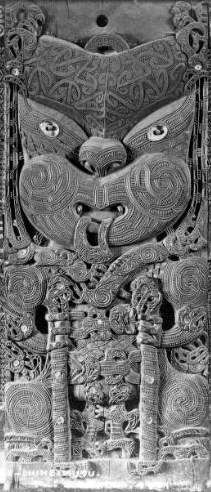Whakairo

Toi whakairo (art carving) or just whakairo (carving) is a Māori traditional art of carving[1] in wood, stone or bone. Wood was formed into houses, fencepoles, containers, taiaha and tool handles. Stone, preferably the very hard pounamu (greenstone), was the chief material for tools of many kinds. Bone was used for fish hooks, needles etc. Following the introduction of metal tools there was a substantial increase in decorative ornamentation, particularly in wood and bone carving.
The Māori Arts and Crafts Institute at Whakarewarewa in Rotorua is a stronghold of traditional carving skills.[2] Hone Taiapa was head of this school for some time. Since the Māori Renaissance there has been a resurgence of interest in whakairo, alongside other traditional Māori practices, with a much greater integration with mainstream contemporary art. The Māori Art Market (funded by the state-sponsored Toi Māori Aotearoa) is a significant venue for the promotion and sale of whakairo.
Many carvers express their practices in explicitly spiritual terms.[3]
Notable carvers include
- Eramiha Neke Kapua (1867–1955)[4]
- Piri Poutapu (1905–1975)
- Hori Pukehika (d. 1932)[5]
- Raharuhi Rukupo (d. 1873)
- Hone Taiapa (1911–1979)[6]
- Pine Taiapa (1901–1972)[7]
- Inia Te Wiata (1915–1971)[8]
- Tene Waitere (1853–1931)
Te Papa and Auckland Art Gallery have substantial holdings of whakairo, with Te Papa in particular having many digitised in their Collections online website.[9]
References
- ↑ Ruatepupuke and the origin of carving
- ↑ "The carver speaks of his work". Waikato Times. 3 August 2007. Retrieved 3 December 2011.
- ↑ "Janet McAllister: Sacred practice of creating art". nzherald.co.nz. 2011. Retrieved 16 October 2011.
- ↑ "Kapua, Eramiha Neke - Biography - Te Ara Encyclopedia of New Zealand". teara.govt.nz. 2011. Retrieved 16 October 2011.
- ↑ "Pukehika, Hori - Biography - Te Ara Encyclopedia of New Zealand". teara.govt.nz. 2011. Retrieved 16 October 2011.
- ↑ "Taiapa, Hone Te Kauru - Biography - Te Ara Encyclopedia of New Zealand". teara.govt.nz. 2011. Retrieved 16 October 2011.
1911–1979
- ↑ "Taiapa, Pineamine - Biography - Te Ara Encyclopedia of New Zealand". teara.govt.nz. 2011. Retrieved 16 October 2011.
- ↑ "Te Wiata, Inia Morehu Tauhia Watene Iarahi Waihurihia - Biography - Te Ara Encyclopedia of New Zealand". teara.govt.nz. 2011. Retrieved 16 October 2011.
- ↑ "woodcarving - Collections Online - Museum of New Zealand Te Papa Tongarewa". collections.tepapa.govt.nz. 2011. Retrieved 16 October 2011.
Further reading
- Archey, G., 1977 Whaowhia: Maori Art and Its Artists. Auckland, Collins.
- Barrow, T., 1963 The Life and Work of the Maori Carver. Wellington, Government Printer.
- Barrow, T., 1965 A Guide to the Maori Meeting House: Te Hau ki Turanga. Wellington, Dominion Museum.
- Barrow, T., 1969 Maori Wood Sculpture of New Zealand. Wellington, Reed.
- Brown, D., 1999 The architecture of the School of Maori Arts and Crafts. Journal of the Polynesian Society 108(3):241-276.
- Brown, D., 2003 Tai Tokerau Whakairo Rakau: Northland Maori Wood Carving. Reed, Auckland.
- Day, K., 2001 Maori Woodcarving of the Taranaki Region. Auckland, Reed.
- Firth, R., 1925 The Maori carver. Journal of the Polynesian Society 34(136):277-291.
- Kimura, A., 1991 "The heart of its people." New Zealand Historic Places 33:43-45.
- Mead, H.M., 1986 Te Toi Whakairo: The Art of Maori Carving. Auckland, Reed Methuen.
- Ngata, A.T., 1958 "The origin of Maori carving". Te Ao Hou 22:30-37, 23:30-33. full text
- Phillipps, W.J., 1941 Maori Carving. New Plymouth, T. Avery and Sons.
- Shadbolt, M., 1973 Pine Taiapa: Master Carver. New Zealand Heritage Vol. 6, Part 87:2433-6.
- Wilson, J. 1993 The Pride of Ngapuhi. New Zealand Historic Places 44:37-40.